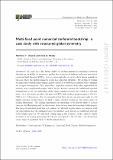Files in this item
Multi-fixed point numerical conformal bootstrap : a case study with structured global symmetry
Item metadata
| dc.contributor.author | Dowens, Matthew T. | |
| dc.contributor.author | Hooley, Chris A. | |
| dc.date.accessioned | 2021-03-26T15:30:16Z | |
| dc.date.available | 2021-03-26T15:30:16Z | |
| dc.date.issued | 2021-03-15 | |
| dc.identifier | 273500123 | |
| dc.identifier | 5b2ca069-07b6-4604-9575-f376060fff4a | |
| dc.identifier | 000629376300002 | |
| dc.identifier | 85107364500 | |
| dc.identifier.citation | Dowens , M T & Hooley , C A 2021 , ' Multi-fixed point numerical conformal bootstrap : a case study with structured global symmetry ' , Journal of High Energy Physics , vol. 2021 , no. 3 , 147 . https://doi.org/10.1007/jhep03(2021)147 | en |
| dc.identifier.issn | 1029-8479 | |
| dc.identifier.other | Jisc: 8167d1ba73ed43ea8d0275a6c71b1301 | |
| dc.identifier.other | publisher-id: jhep03(2021)147 | |
| dc.identifier.other | manuscript: 15104 | |
| dc.identifier.other | arxiv: 2004.14978 | |
| dc.identifier.other | ORCID: /0000-0002-9976-2405/work/91340761 | |
| dc.identifier.uri | https://hdl.handle.net/10023/21728 | |
| dc.description | MTD and CAH acknowledge financial support from UKRI via EPSRC grant numbers EP/R513337/1 and EP/R031924/1 respectively. | en |
| dc.description.abstract | In large part, the future utility of modern numerical conformal bootstrap depends on its ability to accurately predict the existence of hitherto unknown non-trivial conformal field theories (CFTs). Here we investigate the extent to which this is possible in the case where the global symmetry group has a product structure. We do this by testing for signatures of fixed points using a mixed-correlator bootstrap calculation with a minimal set of input assumptions. This ‘semi-blind’ approach contrasts with other approaches for probing more complicated groups, which ‘target’ known theories with additional spectral assumptions or use the saturation of the single-correlator bootstrap bound as a starting point. As a case study, we select the space of CFTs with product-group symmetry O(15) ⊗ O(3) in d = 3 dimensions. On the assumption that there is only one relevant scalar (ℓ = 0) singlet operator in the theory, we find a single ‘allowed’ region in our chosen space of scaling dimensions. The scaling dimensions corresponding to two known large-N critical theories, the Heisenberg and the chiral ones, lie on or very near the boundary of this region. The large-N antichiral point lies well outside the ‘allowed’ region, which is consistent with the expectation that the antichiral theory is unstable, and thus has an additional relevant scalar singlet operator. We also find a sharp kink in the boundary of the ‘allowed’ region at values of the scaling dimensions that do not correspond to the (N, M ) = (3, 15) instance of any large-N -predicted O(N ) ⊗ O(M ) critical theory. | |
| dc.format.extent | 27 | |
| dc.format.extent | 2566583 | |
| dc.language.iso | eng | |
| dc.relation.ispartof | Journal of High Energy Physics | en |
| dc.subject | Conformal and W symmetry | en |
| dc.subject | Conformal field theory | en |
| dc.subject | Global symmetries | en |
| dc.subject | QC Physics | en |
| dc.subject | TK Electrical engineering. Electronics Nuclear engineering | en |
| dc.subject | T-NDAS | en |
| dc.subject.lcc | QC | en |
| dc.subject.lcc | TK | en |
| dc.title | Multi-fixed point numerical conformal bootstrap : a case study with structured global symmetry | en |
| dc.type | Journal article | en |
| dc.contributor.sponsor | EPSRC | en |
| dc.contributor.institution | University of St Andrews. School of Physics and Astronomy | en |
| dc.contributor.institution | University of St Andrews. Centre for Designer Quantum Materials | en |
| dc.contributor.institution | University of St Andrews. Condensed Matter Physics | en |
| dc.identifier.doi | https://doi.org/10.1007/jhep03(2021)147 | |
| dc.description.status | Peer reviewed | en |
| dc.identifier.grantnumber | EP/R031924/1 | en |
This item appears in the following Collection(s)
Items in the St Andrews Research Repository are protected by copyright, with all rights reserved, unless otherwise indicated.

